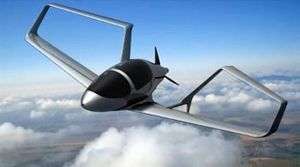Synergy Aircraft Synergy
| Synergy | |
|---|---|
 | |
| Artist's concept | |
| Role | Kit aircraft |
| National origin | United States |
| Manufacturer | Synergy Aircraft |
| Designer | John McGinnis |
| Status | Under development |
| Number built | None |
The Synergy Aircraft Synergy is a proposed five-seat, single-engine, kit aircraft, designed by John McGinnis of Kalispell, Montana and intended for production by his company, Synergy Aircraft.[1][2][3]
The aircraft's closed wing design, termed a "double box tail", is intended to lower induced drag and be stall resistant, along with boundary layer control methods.[2] Many of the details are disclosed in US patent 8657226.
Design and development
Development was started in 2010 to develop the Synergy as a future kit airplane. The Synergy is the first aircraft that was designed to use the 200 hp (149 kW) DeltaHawk V-4 engine. An electric-powered 1/4 scale version of the aircraft has been built and flown via radio control.[2]
The Synergy design was unveiled at the 2011 CAFE Foundation electric aircraft symposium.[4] The aircraft was intended to compete in the 2011 NASA/CAFE Green Flight Challenge,[5] but its funding and engine were delayed, forcing the team to withdraw from the competition.[6]
After receiving the DeltaHawk engine in December 2011 work resumed and a funding drive was launched to complete the prototype. Intended as a Kickstarter crowdfunding project, the initial project application and appeal were rejected on the basis of not fitting in with Kickstarter's creative arts focus.[7] On 13 May 2012, however, Kickstarter informed McGinnis that they had reconsidered and that the project was approved.[8] The project raised US$95,627 gross funds.[9]
By mid-December 2012 McGinnis indicated that the Kickstarter campaign had raised US$80,000 and that he was intending to have a flying proof-of-concept aircraft at AirVenture 2013. He also stated that if the aircraft is not complete then he will not have a display there. The Kickstarter campaign also attracted a lot of interest, but answering email and phones calls has slowed work on the prototype down.[10]
Specifications
Data from Experimental Aircraft Association and Synergy[2][3]
General characteristics
- Crew: 1
- Capacity: 4 passengers
- Length: 21 ft (6.4 m)
- Wingspan: 32 ft (9.8 m)
- Wing area: 144.6 sq ft (13.43 m2)
- Empty weight: 1,650 lb (748 kg)
- Gross weight: 3,100 lb (1,406 kg)
- Powerplant: 1 × DeltaHawk DH200 liquid-cooled V-4 two-stroke diesel engine, 200 hp (150 kW)
Performance
- Range: 1,726 mi; 2,778 km (1,500 nmi) plus reserve
- Wing loading: 23.2 lb/sq ft (113 kg/m2)
References
- ↑ "Synergy Aircraft Hopes to be the Future of Flight". Albertson, Kristi, Daily Inter Lake. 2011-05-21. Retrieved 2011-05-09.
- 1 2 3 4 "'Synergy' Project Revealed". EAA. 2011-04-29. Retrieved 2011-04-14.
- 1 2 "Synergy Aircraft". Synergy Aircraft. 2012-04-27. Retrieved 2012-08-07.
- ↑ "EAA News - 'Synergy’ Project Revealed". Eaa.org. 2011-04-29. Retrieved 2012-05-29.
- ↑ "Odd Diesel Airplane Aims For Maximum Efficiency". Paur, Jason, Wired (magazine). 2011-05-03. Retrieved 2011-04-14.
- ↑ "NASA - After the Challenge: Synergy Aircraft". Nasa.gov. 2012-11-23. Retrieved 2013-04-10.
- ↑ "No Kickstart For Synergy". Avweb.com. 2012-04-24. Retrieved 2012-05-29.
- ↑ Grady, Mary (16 May 2012). "Kickstarter Relents, OK's Synergy Project". AVweb. Retrieved 5 June 2012.
- ↑ "Synergy Aircraft Project on Kickstarter". kickstarter.com.
- ↑ Pew, Glenn (15 December 2012). "Synergy Efficient Aircraft Ready For OSH?". AVweb. Retrieved 17 December 2012.